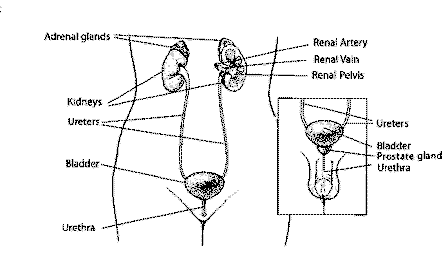Erlanger Resources
Academic Urologists at Erlanger
The adrenals are small glands that sit above each of the kidneys, as shown in the picture below. The kidneys are found deep inside the upper part of the belly (abdomen).
The adrenal gland has 2 parts. The outer part, called the cortex, is where adrenal cortical tumors start. The cortex makes certain hormones for the body. These hormones are called steroids.
The inner part of the adrenal gland, called the medulla, is really part of the nervous system. Nervous system hormones are made in the medulla. Tumors of the adrenal medulla are not covered here. This information is only about tumors of the adrenal cortex.
Adrenal cortex tumors
There are 2 main types of adrenal cortex tumors.
- Benign adenoma -- these tumors are not cancer
- Adrenal cortical carcinoma -- these tumors are cancer
Benign ademonas
Most tumors of the adrenal cortex are benign adenomas. These are small tumors, most of the time less than 2 inches (5 centimeters) across. In most cases, they occur in only one adrenal gland, but sometimes are in both glands.
Most people with adrenal adenomas have no symptoms. They don't know they have a tumor unless it is found when tests are being done because of other health problems. Some of these tumors make excess hormones, which may or may not cause symptoms. Many of the hormone-related symptoms of adenomas are the same as those from adrenal carcinomas (cancers).
Treatment: Adenomas can be cured by taking out the adrenal gland that contains the tumor. Some adrenal adenomas can be treated with medicine. This might be a good option for patients with other medical problems who might not be able to have surgery. Still other small adenomas that are not causing any symptoms do not need any treatment at all.
When an adrenal tumor is found "by accident," tests are often done to see if it is making hormones. If it is, surgery is often needed to take out the adrenal gland with the tumor. If it is not making hormones, surgery may only be needed if the tumor is likely to be cancer. Tumors that are small are less likely to be cancer, and are often watched but not treated. A CT (or MRI) scan will likely be done about 6 months later to see if the tumor has grown. If it has, the tumor may need to be removed. If it hasn't grown, hormone levels will be watched over the next few years. If the tumor stays small and doesn't make any hormones, it may not need to be treated at all.
The rest of this document refers to adrenal cancers only, and not to adenomas.
Adrenal cortical cancer
Adrenal cortical cancers are usually found because of the symptoms they cause. They may make hormones that cause body changes such as weight gain, fluid build-up, early puberty in children, or excess facial or body hair in women. Some adrenal cancers get very large and cause symptoms by pressing on other organs. This can cause pain, a feeling of fullness, and weight loss because it is hard to eat very much. In most cases, adrenal cortical cancers are much larger than adenomas. If a tumor is larger than about 2 to 2-1/2 inches (5 or 6 centimeters), it is most likely cancer.
Most cancers found in the adrenal gland did not start there and are not adrenal cortical
cancers. These cancers started in other organs and then spread to the adrenal glands. For example, lung and breast cancers often spread to the adrenal glands. But these cancers are named after the place where they started. They are not called adrenal cancers, and they are treated like the cancers where they started.


